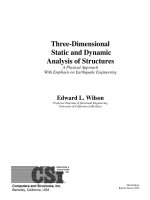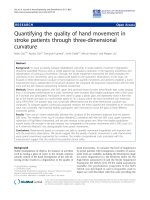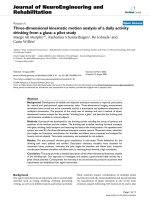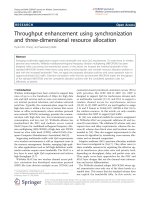Three Dimensional Integration and Modeling A Revolution in RF and Wireless Packaging by Jong Hoon Lee Emmanuil Manos M Tentzeris and Constantine A Balanis_10 pot
Bạn đang xem bản rút gọn của tài liệu. Xem và tải ngay bản đầy đủ của tài liệu tại đây (210.86 KB, 10 trang )
99
REFERENCES
[1] K. Lim, S. Pinel, M. F. Davis, A. Sutono, C. -H. Lee, D. Heo, A. Obatoynbo, J.
Laskar, E. M. Tentzeris, and R. Tummala, “RF-system-on-package (SOP) for wire-
less communications,” IEEE Microwave Magazine, vol. 3, no. 1, pp. 88–99, Mar. 2002,
doi:10.1109/MMW.2002.990700.
[2] C. H. Doan, S. Emami, D. A. Sobel, A. M. Niknejad, and R. W. Brodersen, “Design con-
siderations for 60GHz CMOS radios,” IEEE Communication Magazine, vol. 42, no. 12, pp.
132–140, Dec. 2004, doi:10.1109/MCOM.2004.1367565.
[3] H. H. Meinel, “Commercial applications of millimeter waves History, Present Status, and
Future Trends,” IEEE Transaction on Microwave Theory and Technique, vol. 43, no. 7, pp.
1639–1653, July 1995, doi:10.1109/22.392935.
[4] M. M. Tentzeris, J. Laskar, J. Papapolymerou, D. Thompson, S. Pinel, R. L. Li, J. H. Lee,
G. DeJean, S. Sarkar, R. Pratap, R. Bairavasubramanian, and N. Papageorgiou, “RF SOP
for multi-band RF and millimeter-wave systems,” Advanced Packaging Magazine, pp. 15–16,
April 2004.
[5] D. C. Thompson, O. Tantot, H. Jallageas, G. E. Ponchak, M. M. Tentzeris, and J. Papa-
polymerou, “Characterization of Liquid Crystal Polymer (LCP) Material and Transmission
Lines on LCP Substrates from 30–110 GHz,” IEEE Transactions on Microwave Theory and
Techniques, vol.52, no. 4 , pp. 1343–1352, April 2004, doi:10.1109/TED.2003.810465.
[6] J. Lee, K. Lim, S. Pinel, G. DeJean, R. L. Li, C. -H. Lee, M. F. Davis, M. Tentzeris, and
J. Laskar, “Advanced System-on-Package (SOP) Multilayer Architectures for RF/Wireless
Sy stems uptoMillimeter-Wave Frequency Bands,” inProc. Asian Pacific MicrowaveConference,
Seoul, Korea, Nov. 2003, pp. FA5
01.
[7] V. Kondratyev, M. Lahti, and T. Jaakola, “On the design of LTCC filter for millimeter-
waves,” in 2003 IEEE MTT-S Int. Microwave Sym. Dig., P hiladelphia, PA., June 2003, pp.
1771–1773.
[8] R. L. Li, G. DeJean, M. M. Tentzeris, J. Laskar, and J. Papapolymerou, “LTCC Multilayer
based CP Patch Antenna Surrounded by a Soft-and-Hard Surface for GPS Appli-
cations,” in 2003 IEEE-APS Symposium, Columbus, OH, June 2003, pp. II.651–654,
doi:10.1109/IEDM.1989.74183.
[9] C. H. Lee, A. Sutono, S. Han, K. Lim, S. Pinel, J. Laskar, and E. M. Tentz eris, “A Compact
LTCC-based Ku-band Transmitter Module,” IEEE Transactions on Advanced Packaging, Vol.
25, No. 3, Aug. 2002, pp. 374–384, doi:10.1109/IEDM.1990.237127.
100 REFERENCES
[10] Y. Rong, K. A. Zaki, M. Hageman, D. Stevens, and J. Gipprich, “Low-Temperature
Cofired Ceramic (LTCC) Ridge Waveguide Bandpass Chip Filters,” IEEE Transac-
tion on Microwave Theory and Technique, Vol. 47, No. 12, pp. 2317–2324, Dec. 1999,
doi:10.1109/IEDM.2000.904284.
[11] Yong Huang, “A Broad-Band LTCC Integrated Transition of Laminated Waveguide to Air-
Filled Waveguide for Millimeter-Wave Applications,” IEEE Transaction on Microwave Theory
and Technique, Vol. 51, No. 5, pp. 1613–1617, May 2003, doi:10.1109/96.544361.
[12] W. -Y. Leung, K. -K. M. Cheng, and K. -L. Wu, “Multilayer LTCC Bandpass Filter Design
with Enhanced Stopband Characteristics,” IEEE Microwave and Wireless Components Letters,
Vol. 12, No. 7, pp. 240–242, May 2002.
[13] Y. Rong, K. A. Zaki, M. Hageman, D. Stevens, and J. Gipprich, “Low Temperature Cofired
Ceramic (LTCC) Ridge Waveguide Multiplexers,” in 2000 IEEE MTT-S Int. Microwave
Sym. Dig., Boston, MA., June 2000, pp. 1169–1172, doi:10.1109/TMTT.2004.825738.
[14] R. Lucero, W. Qutteneh, A. Pavio, D. Meyers, and J. Estes, “Design of An LTCC Switch
Diplexer Front-End Module for GSM/DCS/PCS Application,” in 2001 IEEE Radio Fre-
quency Integrated Circuit Sym., Phoenix, AZ., May 2001, pp. 213–216.
[15] C. H. Lee, A. Sutono, S. Han, K. Lim, S. Pinel, J. Laskar, and E. M. Tentz eris, “A Compact
LTCC-based Ku-band Transmitter Module,” IEEE Transactions on Advanced Packaging, Vol.
25, No. 3, pp. 374–384, Aug. 2002.
[16] B. G. Choi, M. G. Stubbs, and C. S. Park, “A Ka-Band Narrow Bandpass Filter Using LTCC
Technology,” IEEE Microwave and Wireless Components Letters, Vol. 13, No. 9, pp. 388–389,
Sep. 2003.
[17] V. Piatnitsa, E. Jakku, and S. Leppaevuori, “Design of a 2-Pole LTCC Filters for Wireless
Communications,” IEEE Transactions on Wireless Communications, Vol. 3, No. 2, Mar. 2004,
pp. 379–381, doi:10.1109/TADVP.2002.805315.
[18] M. J. Hill, R. W. Ziolkowski, and J. Papapolymerou, “Simulated and Measured Results
from a Duroid-Based Planar MBG Cavity Resonator Filter,” IEEE Microwave and Wireless
Components Letters, Vol. 10, No. 12, pp. 528–530, Dec. 2000, doi:10.1109/22.808977.
[19] H. -J. Hsu, M. J. Hill, J. Papapolymerou, and R. W. Ziolkowski, “A Planar X-Band Electro-
magnetics Band-Gap(EBG) 3-Pole Filter,” IEEE Microwave and Wireless Components Letters,
Vol. 12, No. 7, pp. 255–257, July 2002, doi:10.1109/TMTT.2003.810146.
[20] C. A.Tavernier, R. M. Henderson, and J. Papapolymerou, “A Reduced-Size Silicon Microma-
chined High-QResonator at 5.7 GHz,”IEEETransactionon MicrowaveTheory and Technique,
Vol. 50, NO. 10, pp. 2305–2314, Oct. 2002, doi:10.1109/LMWC.2002.801130.
[21] A. El-Tager, J. Bray, and L. Roy, “High-Q LTCC Resonators For Millimeter Wave Appli-
cations,” in 2003 IEEE MTT-S Int. Microwave Sym. Dig, Philadelphia, PA., June 2003, pp.
2257–2260.
REFERENCES 101
[22] P. Ferrand, D. Baillargeat, S. Verdeyme, J. Puech, M. Lahti, and T. Jaakola, “LTCC reduced-
size bandpass filters based on capacitively loaded cavities for Q band application,” in 2005
IEEE MTT-S Int. Microwave Sym. Dig, Long Beach, CA., June 2005, pp. 1789–1792.
[23] X. Gong, W. J. Chappell, and L. P. B. Katehi, “Multifunctional Substrates For High-
Frequency Applications,” IEEE Microwave and Wireless Components Letters, Vol. 13, No.
10, pp. 428–430, Oct. 2003, doi:10.1109/TADVP.2002.805315.
[24] Y. C. Lee, W. -I. Chang, Y. H. Cho, and C. S. Park, “A Very Compact 60GHz Transmitter
Integrating GaAs MMICs on LTCC Passive Circuits for Wireless Terminals Applications,”
in 2004 IEEE MTT-S Int. Microwave Sym. Dig, Fort Worth, TX., Oct. 2004, pp. 313–316,
doi:10.1109/LMWC.2003.817139.
[25] K. Ohata, T. Inoue, M. Funabashi, A. Inoue, Y. Takimoto, T. Kuwabara, S. Shi-
nozaki, K. Maruhashi, K. Hosaya, and H. Nagai, “Sixty-GHz-Band Ultra-Miniature
Monolithic T/R Modules for Multimedia Wireless Communication Systems,” IEEE Trans-
action on Microwave Theory and Technique, vol. 44, no. 12, pp. 2354–2360, Dec. 1996,
doi:10.1109/TWC.2003.821141.
[26] K. Ohata, K. Maruhashi, M. Ito, S. Kishimoto, K. Ikuina, T. Hashiguchi, K. Ikeda, and N.
Takahashi, “1.25 Gbps Wireless Gigabit Ethernet Link at 60 GHz-Band,” in 2003 IEEE
MTT-S Int. Microwave Sym. Dig, Philadelphia, PA, June 2003, pp. 373–376.
[27] J. Mizoe, S. Amano, T. Kuwabara, T. Kaneko, K. Wada, A. Kato, K. Sato, and M. Fujise,
“Miniature 60 GHz Transmetter/Receiver Modules on AIN Multi-Layer High Temperature
Co-Fired Ceramic,” in 1999 IEEE MTT-S Int. Microwave Sym. Dig, Anaheim, CA, June
1999, pp. 475–478, doi:10.1109/LMWC.2002.801136.
[28] A. Tavakoli, N. Darmvandi, andR. M. Mazandaran, “Analysis of cross-shaped dual-polarized
microstrip patch antennas,” in 1995 IEEE AP-S Int. Sym. Dig., Newport Beach, CA., June
1995, pp. 994–997, doi:10.1109/TMTT.2002.80342.
[29] M. F. Davis, A. Sutono, A. Obatoyinbo, S. Chakrabor ty, K. Lim, S. Pinel, J. Laksar, and
R. Tummala, “Integrated RF architectures in fully-organic SOP technology,” in Proc. 2001
IEEE EPEP Topical Meeting, Boston, MA, Oct. 2001, pp. 93–96.
[30] K. Lim, A. Obatoyinbo, M. F. Davis, J. Laksar, and R. Tummala, “Development of planar
antennas in multi-layer package for RF-system-on-package applications,” in Proc. 2001IEEE
EPEP Topical Meeting, Boston, MA, Oct. 2001, pp. 101–104.
[31] M. F. Davis, A. Sutono, K. Lim, J. Laksar, V. Sundaram, J. Hobbs, G. E. White, and R. Tum-
mala, “RF-microwave multi-layer integrated passives using fully organic system-on-package
(SOP) technology,” in Proc. 2001 IEEE International Microwave Symposium, vol. 3, Phoenix,
AZ, May 2001, pp. 1731–1734, doi:10.1109/LMWC.2003.818525.
[32] J. M. Hobbs, S. Dalmia, V. Sundaram, L. Wan, W. Kim, G. White, M. Swaminathan, and
R. Tummala, “Development and characterization of embedded thin-film capacitors for mixed
102 REFERENCES
signal applications on fully organic system-on-package technology,” in Proc. IEEE 2002Radio
and Wireless Conference, RAWCON 2002, Boston, MA, Aug. 2002, pp. 201–204.
[33] R. Ulrich and L. Schaper, Eds., Integrated Passive Component Technology: IEEE Press/Wiley,
2003.
[34] J. Laksar, M. Tentzeris, K. Lim, S. Pinel, M. Davis, A. Rhagavan, M. Maeng, S. -W. Yoon,
and R. Tummala, “Advanced system-on-package RF front-ends for emerging wireless com-
munications,” in Proc. 2002 Asian-Pacific Microwave Symposium, Kyoto, Japan, Nov. 2002, pp.
III. 1703–1708.
[35] M. M, Tentzeris, J. Laskar, J. Papapolymerou, S. Pinel, V. Palazzari, R. Li, G. DeJean,
N. Papageorgiou, D. Thompson, R. Bairavasubramanian, S. Sarkar, and J. -H. Lee, “3-D-
integrated RFand millimeter-wave functions andmodules using liquid crystal polymer (LCP)
system-on-package technology,” IEEE Transaction on Advanced Packaging, vol. 27, no. 2, pp.
332–340, May 2004.
[36] K. Lim, A. Obatoyinbo, A. Sutuno, S. Chakraborty, C. Lee, E. Gebara, A. Raghavan, and J.
Laskar, “A highly integrated transceiver module for 5.8 GHz OFDM communication system
using multi-layer packaging technology,” in IEEE MTT-S Int. Microwave Symp, Dig., vol. 1,
2001, pp. 65–68.
[37] W. Diels, K. Vaesen, K. Wambacq, P. Donnay, S. De Raedt, W. Engels, and M. Bolsens,
“A single-package integration of RF blocks for a 5 GHz WLAN applic ation,” IEEE
Trans. Comp. Packaging. Technol. Adv. Packag. pt. B, vol. 24, Aug. 2001, pp. 384–391,
doi:10.1109/TADVP.2004.828814.
[38] P. G. Barnwell and L. Wood, “A novel thick-film on ceramic MCM technology offer-
ing MCM-D performance,” in 6
th
International Conf. on MCMs, Denver, CO, 1997, pp.
48–52.
[39] P. G. Barnwell, C. E. Free, and C. S. Aitchison, “A novel thick-film on ceramic microwave
technology,” in Proc. 1998 Asian-Pacific Microwave Symposium, Yokohama, Japan, Dec. 1998,
pp. 189–192, doi:10.1109/6040.938307.
[40] B. Geller, B. Thaler, A. Fathy, M. J. Liberatore, H. D. Chen, G. Ayers, V. Pendrick, and Y.
Narayan, “LTCC-M: An enabling technology for high performance multilayer RF systems,”
in IEEE MT T-S Int. Microwave Symp., Dig., Anaheim, CA, June 1999, pp. 189–192.
[41] D. M. Pozar, Microwave Engineering, 2
nd
ed. New York: Wiley, 1998.
[42] D. M. Pozar and D. H. Schauber, Microstrip Antennas, Piscataway, NJ/U.S.A.:IEEE press,
1995.
[43] Robert E. Collin, Foundations for Microwave Engineering, New York, NY/U.S.A: McGraw
Hill, 1992.
[44] J S.Hong andM. J. Lancaster,“Coupling of microstrip squareopen-loop resonators for cross-
coupled planar microwave filters,” IEEE Transaction on Microwave Theory and Technique, Vol.
44, No. 12, pp. 2099–2109, Dec. 1996.
REFERENCES 103
[45] J. -S. Hong and M. J. Lancaster, “Design of Highly Selective Microstrip BandpassFilters with
a Single Pair of Attenuation Poles at Finite Frequencies,” IEEE Transactions on Microwave
Theory and Techniques, vol. 48, pp. 1098–1107, July 2000.
[46] J. -G. Yook, N. I. Dib,and L.P. B. Katehi, “Characterization of High Frequency Interconnects
Using Finite Difference Time Domain and Finite Element Methods,” IEEE Transactions on
Microwave Theory and Techniques, vol. 42, pp. 1727–1736, Sept. 1994, doi:10.1109/JSSC.
2007.894325.
[47] Y. Cassivi and K. Wu, “Low Cost Microwave Oscillator Using Substrate Integrated Waveg-
uide Cavity,” IEEE Microwave and Wireless Components Letters, Vol. 13, No. 2, pp. 48–50,
Feb. 2003, doi:10.1109/JSSC.2005.858626.
[48] J. -S. Hong and M. J. Lancaster, Microstr ip Filters for RF/Microwave Applications,NewYork,
NY/U.S.A: John Wiley $ Sons, Inc., 2001.
[49] J H. Lee, S. Pinel, J. Papapolymerou, J. Laskar, and M.M. Tentzeris, “Low Loss LTCC Cav-
ity FiltersUsing System-on-Package Technology at 60 GHz,” IEEE Transactionon Microwave
Theory and Technique, vol. 53, no. 12, pp. 231–244, Dec. 2005, doi:10.1109/22.554558.
[50] J. Heyen, A. Gordiyenko, P. Heide, and A. F. Jacob, “Vertical Feedthroughs for Millimeter-
Wave LTCC Modules,” in 2003 IEEE European Microwave Conference, Munich, Germany,
Oct. 2003, pp. 411–414.
[51] H. -C. Chang and K. A. Zaki, “Evanescent-mode coupling of dual-mode rectangular waveg-
uide filters,” IEEE Transaction on Microwave Theory and Technique, vol. 39, no. 8, pp.
1307–1312, Aug. 1991.
[52] K. Sano and M. Miyashita, “Application of the planar I/O terminal to dual-mode dielectric-
waveguide filters,” IEEE Transaction on Microwave Theory and Technique, vol. 48, no. 12, pp.
2491–2495, Dec. 2000, doi:10.1109/TADVP.2004.831868.
[53] A. I. Atia and A. E. Williams, “Narrow-bandpass waveguide filters,” IEEE Transac-
tion on Microwave Theory and Technique, vol. MTT-20, no. 4, pp. 258–265, April 1972,
doi:10.1109/TMTT.2004.825738.
[54] A. I. Atia and A. E. Williams, “Nonminimum-phase optimum-amplitude bandapss waveg-
uide filters,” IEEE Transaction on Microwave Theory and Technique, vol. MTT-22, no. 4, pp.
425–431, April 1974.
[55] D.Deslandes andK. Wu, “Substrate IntegratedWaveguide Dual-Mode Filters for Broadband
Wireless Systems,” in 2003 Radio and Wireless Conf., Boston, MA, Aug. 2003, pp. 385–388.
[56] M. Guglielmi, P. Jarry, E. Kerher ve, O. Roquerbrun, and D. Schmitt “A new family of all-
inductive dual-mode filters,” IEEE Transaction on Microwave Theory and Technique, vol.
49, no. 10, pp. 1764–1769, Oct. 2001, doi:10.1109/8.410216.
[57] P. Savi, D. Trinchero, R. Tascone, and R. Orta “A new approach to the design of dual-
moderectangular waveguide filterswith distr ibuted coupling,” IEEETransactiononMicrowave
Theory and Technique, vol. 45, no. 2, pp. 221–228, Feb. 1997.
104 REFERENCES
[58] J. -F. Liang, X. -P. Liang, K. A. Zaki, and A. E. Atia “Dual-mode dielectric or air-filled
rectangular waveguide filters,” IEEE Transaction on Microwave Theory and Technique, vol. 42,
no. 7, pp. 1330–1336, July. 1994.
[59] A. E. Williams and A. E. Atia, “Dual-mode canonical waveguide filters,” IEEE Transac-
tion on Microwave Theory and Technique, vol. MTT-25, no. 12, pp. 1021–1026, Dec 1977,
doi:10.1109/LMWC.2006.877130.
[60] C. Kdsia, R. Cameron, and W. -C. Tang, “Innovations in microwave filters and multiplexing
networks for communications satellite systems,” IEEE Transaction on Microwave Theory and
Technique, vol. 40, no. 6, pp. 1133–1149, June 1992.
[61] L. Accatino, G. Bertin, and M. Mongiardo, “Elliptical cavity resonators for dual-mode
narrow-band filters,” IEEE Transaction on Microwave Theory and Technique, vol. 45, no. 12,
pp. 2393–2401, Dec. 1997.
[62] A. E. Williams, “A Four-Cavity Elliptic Waveguide Filter,” IEEE Transaction on Microwave
Theory and Technique, vol. MTT-18, no. 12, pp. 1109–1114, Dec. 1970.
[63] I. Awai, A. C. Kundu, and T. Yamashita, “Equivalent-circuit representation and explanation
of attenuation poles of a dual-mode dielectric-resonator bandpass filter,” IEEE Transac-
tion on Microwave Theory and Technique, vol. 46, no. 11, pp. 2159–2163, Dec. 1998,
doi:10.1109/22.543968.
[64] M. Sagawa, K. Takahashi, and M. Makimoto, “Miniaturized hairpin resonator filters and
their application to receiver front-end MIC’s,” IEEE Transaction on Microwave Theory and
Technique, vol. 37, no. 12, pp. 1991–1997, May 1989, doi:10.1109/22.848492.
[65] K. A. Zaki, C. Chen, and A. E. Atia, “A circuit model of probes in dual-mode cavities,” IEEE
Trans. Microwave Theor y Tech., vol. 36, pp. 1740–1746, Dec. 1988, doi:10.1109/22.310581.
[66] J. B. Thomas, “Cross-coupling in coaxial cavity filters – a tutorial overview,” IEEE Trans-
action on Microwave Theory and Technique, vol. 51, no. 4, pp. 1368–1376, April 2003,
doi:10.1109/LMWC.2003.808720.
[67] F. Purroy and L. Pradell, “New theoretical analysis of the LRRM calibration technique for
vector network anal yzers,” IEEE Transaction on Instrumentation and Measurement, vol. 50,
issues 5, pp. 1307–1314, Oct. 2001.
[68] M. J. Vaughan, K. Y. Hur, and R. C. Compton, “Improvement of microstrip patch antenna
radiation patterns,” IEEE Trans. Antennas P ropagat., vol. 42, no. 6, pp. 882–885, June 1994.
[69] R. Gonzalo, P. de. Maagt, and M. Sorolla, “Enhanced patch-antenna performance by sup-
pressing sur face waves using photonic-bandgap substrates,” IEEE Trans. Microwave Theory
Tech., vol. 47, no. 11, pp. 2131–2138, Nov. 1999.
[70] R. Coccioli, F. -R. Yang, K. -P. Ma, and T. Itoh, “Aperture-coupled patch antenna on UC-
PBG substrate,” IEEE Trans. Microwave Theory Tech., vol. 47, no. 11, pp. 2123–2130, Nov.
1999, doi:10.1109/22.85405.
REFERENCES 105
[71] R. L. Li, G. DeJean, J. Papapolymerou, J. Laskar, and M. M. Tentzeris, “Radiation-pattern
improvement of patch antennason a large-size substrate using a compact soft surface structure
and its realization on LTCC multilayer technology,” IEEE Trans. Antennas and Propagation,
vol. 53, no. 1, pp. 200–208, Jan. 2000, doi:10.1109/22.899003.
[72] M. Tentzeris, R. L. Li, K. Lim, M. Maeng, E. Tsai, G. DeJean, and J. Laskar, “Design of
compact stacked-patch antennas on LTCC technology for wireless communication applica-
tions,” Proceedings of IEEE Antenna and Propagation Society International Symposium, vol. 2,
pp. 500–503, June 2002, doi:10.1109/TMTT.1972.1127732.
[73] C. Balanis, Antenna Theory. Canada: John Wiley & Sons, Inc, 1997,
doi:10.1109/TMTT.1974.1128242.
[74] P. F. M. Smulder, “Exploiting the 60 GHz Band for Local Wireless Multimedia Access:
Prospects and Future Directions,” IEEE Communications Magazine, vol.40, pp. 140–147, Jan.
2002.
[75] L. Xue, C. C. Liu, H. -S Kim, and S. Tiwari, “Three-dimensional integration: technology,
use, and issues for mixed-signal applications,” IEEE Trans. on Electron Devices., vol. 50, no.
3, pp. 601–608, Mar. 2003, doi:10.1109/22.954782.
[76] S. Kawamura, N. Sasaki, I. Iwai, M. Nakano, and M. Takagi, “Three-dimensional CMOS
IC’s fabricated by using beam recrystallization,” IEEE Electron Device Lett., vol. EDL-4, pp.
601–608, Mar. 2003, doi:10.1109/22.557603.
[77] Y. Akasaka and T. Nishimura, “Concept and basic technologies for 3-D IC sturcture,” in
IEDM Tech. Dig., 1986, pp. 488–491, doi:10.1109/22.299726.
[78] T. Kunio, K. Oyama, Y. Hayashi, and M. Morimoto, “Three-dimensional IC’s, hav-
ing four stacked active device layers,” in IEDM Tech. Dig., 1989, pp. 837–840,
doi:10.1109/TMTT.1977.1129267.
[79] K. Yamazaki, Y.Itoh, A.Wada, K. Morimoto,and Y. Tomita,“4-layer 3-D IC technologiesfor
parallel signal processing,” in IEDM Tech. Dig., 1990, pp. 599–602, doi:10.1109/22.141345.
[80] K. W. Lee, T. Nakamura, T. Ono, Y. Yamada, T. Mizukusa, H. Hashimoto, K. T. Park,
H. Kurino, and M. Koyanagi, “Three-dimensional shared memory fabricated using wafer
stacking technology,” in IEDM Tech. Dig., 2000, pp. 165–168, doi:10.1109/22.643850.
[81] M. B. Kleiner, S. A. Kuhn, P. Ramm, and W. Weber, “Performance improve-
ment of the memory hierarchy of RISC-systems by application of 3-D technology,”
IEEE Trans. on Comp. Packag. Manufact. Technol., vol. 19, pp. 709–718, Nov. 1996,
doi:10.1109/TMTT.1970.1127419.
[82] R. L. V. Tuyl, “Unlicensed millimeter wave communications: A new opportunity for MMIC
technology at 60 GHz,” in IEEE GaAs IC Symp., 1996, pp. 3–5, doi:10.1109/22.739300.
[83] H. Daembkes, “GaAs MMIC based components and frontends for millimeter-wave c ommu-
nication and sensor system,” in Microwave Sys. Conf., 1995, pp. 83–86, doi:10.1109/22.44113.
106 REFERENCES
[84] S. Reynolds, “60 GHz transceiver circuits in SiGe Bipolar Technology,” in IEEE Int’l Solid-
State Circuits Conf. Dig. Tech. Papers, Feb. 2004, pp. 442–443, doi:10.1109/22.17408.
[85] T. Yao, M. Q. Gordon, K. K. W. Tang, K. H. K. Yau, M. -T. Yang, P. Schvan,
and S. P. Voinigescu, “Algorithmic design of CMOS LNAs and PAs for 60-GHz
radio,” IEEE Journal of S olid-State Circuit, vol. 42, no. 5, pp. 1044–1057, May 2007,
doi:10.1109/TMTT.2003.809180.
[86] B. Razavi, “A 60-GHz CMOS receiver front-end,” IEEE Journal of Solid-State Circuit, vol.
41, no. 1, pp. 17–22, Jan. 2006, doi:10.1109/19.963202.
[87] V. A. Chiriac and T. -Y. T. Lee, “Thermal assessment of RF-integrated LTCC front
end modules,” IEEE Trans. on Adv. Packag., vol. 27, no. 3, pp. 545–557, Aug. 2004,
doi:10.1109/8.301717.
[88] D. C. Thompson, O. Tantot, H. Jallageas, G. E. Ponchak, and M. M. Tentzeris, “Charac-
terization of liquid crystal polymer (LCP) material and transmission lines on LCP substrates
from 30–110GHz,” IEEE Trans. Microwave Theory Tech., vol. 52, no. 4, pp. 1343–1352, Apr.
2004, doi:10.1109/22.798009.
[89] K. Jayaraj, T.E. Noll,and D.R. Singh, “RF characterization of a low-cost multichip packaging
technology for monolithic microwave and millimeter wave integrated circuits,” in URSI Int.
Signals, Systems, and Electronics Symp., Oct. 1995, pp. 443–446, doi:10.1109/22.798008.
[90] E. C. Culberston, “A new laminate material for high performance PCBs: Liquid crystal
polymer copper clad films,” in IEEE Electronic Components and Technology Conf., May 2002,
pp. 520–523, doi:10.1109/TAP.2004.840754.
[91] K. Jayaraj,T. E. Noll, and D. R. Singh, “A low cost multichip packaging technology for mono-
lithic microwave integrated circuits,” IEEE Trans. Antennas Propagat., vol. 43, pp. 992–997,
Sept. 1995.
[92] B. Farrell and M. St. Lawrence, “The processing of liquid crystalline polymer printed circuits,”
in IEEE Electronic Components and Technology Conf., May 2002, pp. 667–671.
[93] C. Murphy, private communication, Jan. 2004.
[94] D. C. Thompson, M. M. Tentzeris, and J. Papapolymerou, “Packaging of MMICs in multi-
layer LCP substrates,” IEEE Microwave Wireless Compon. Lett., vol. 16, iss. 7, pp. 410–412,
July 2006, doi:10.1109/35.978061.
[95] Y. Li and M. M. Tentzeris, “Design and characterization of novel paper-based inkjet-printed
RFID and microwave structures for telecommunication and sensing applications,” in 2007
IEEE MTT-S Int. Microwave Sym. Dig., Honolulu, HW, June 2007, pp. 1633–1636.
107
Author Biography
Manos M. Tentzeris was born and grew up in Piraeus, Greece. He graduated from Ionidios Model
School of Piraeus in 1987 and he received the Diploma degree in Electrical Engineering and Com-
puter Science (Magna Cum Laude) from the National Technical University in Athens, Greece, in
1992 and the M.S. and Ph.D. degrees in Electrical Engineering and Computer Science from the
University of Michigan, Ann Arbor in 1993 and 1998.
He is currently an Associate Professor with the School of ECE, Georgia Tech and he has
published more than 250 papers in refereed Journals and Conference Proceedings, 1 book and 8
book chapters, while he is in the process of writing 2 books. He is currently the Georgia Electronic
Design Center Associate Director for RFID/Sensors research, while he had been the GT-Packaging
Research Center (NSF-ERC) Associate Director for RF research and the leader of the RF/Wireless
Packaging Alliance from 2003-2006. Also, Dr. Tentzeris is the Head of the A.T.H.E.N.A.
Research Group (20 students and researchers) and has established academic programs in Highly
Integrated/Multilayer Packaging for RF and Wireless Applications using ceramic and organic
flexible materials, paper-based RFID’s and sensors, Microwave MEM’s, SOP-integrated (UWB,
mutliband, conformal) antennas and Adaptive Numerical Electromagnetics (FDTD, MultiResolu-
tion Algorithms). He was the 1999 Technical Program Co-Chair of the 54th ARFTG Conference
and he is currently a member of the technical program committees of IEEE-IMS, IEEE-AP and
IEEE-ECTC Symposia. He will be the TPC Chair for the IMS 2008 Conference. He was the
Chairman for the 2005 IEEE CEM-TD Workshop. He was the Chair of IEEE-CPMT TC16
(RF Subcommittee) and he was the Chair of IEEE MTT/AP Atlanta Sections for 2003. He is a
Senior Member of IEEE, a member of MTT-15 Committee, an Associate Member of European
Microwave Association (EuMA), a Fellow of the Electromagnetics Academy, and a member of
Commission D, URSI and of the Technical Chamber of Greece. His hobbies include basketball,
ping-pong and travel.
Jong-Hoon Lee received the B.S. Degree in electrical engineering from The Pennsylvania State
University, University Park, with high honor in the spring of 2001. He joined the electrical engi-
neering at The Georgia Institute of Technology, in the fall of 2001 and received an M.S. degree in
the fall of 2004 and a Ph.D. in the summer of 2007 under the advice of Prof. Manos M. Tentzeris.
Dr. Lee is now the senior CAE engineer at RFMD in the design integration department.
His research interests are SOP and SIPpackaging technologies formicrowave/mmW systems,
passive/active circuits for RF/wireless systems, DSP-based predictors to improve the computational
108 THREE-DIMENSIONAL INTEGRATION
efficiency of the simulation of highly resonant RF geometries. Jong-Hoon Lee also researches the
development of the LTCC system-on-package (SOP) module for millimeter-wave wireless systems,
FDTD/Spice interface, and active devices modeling with FDTD and MRTD. He was a member of
the GeorgiaTech ATHENA research group, NSFpackaging research center, the Georgia Electronic
Design Center, and Tau Beta Pi Honor association.









